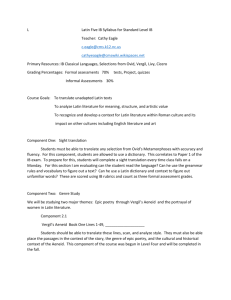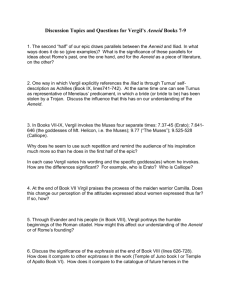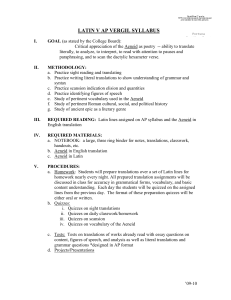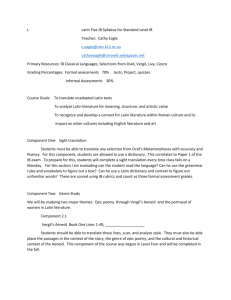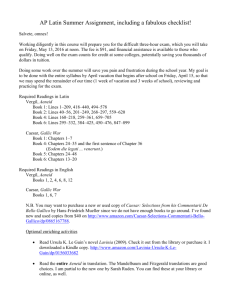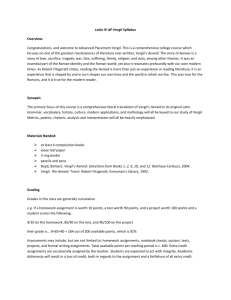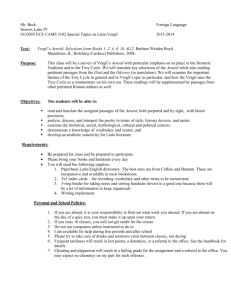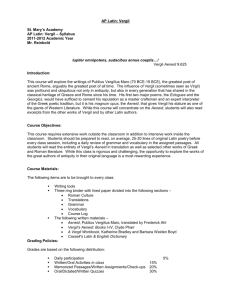Latin 41 - Amherst College
advertisement
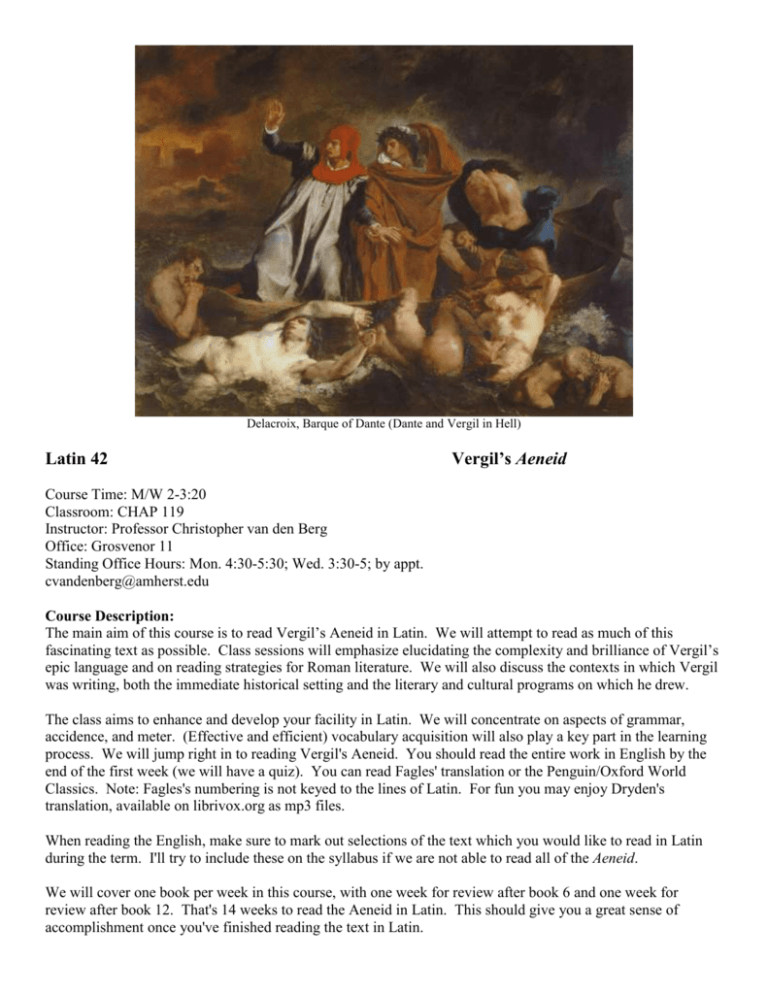
Delacroix, Barque of Dante (Dante and Vergil in Hell) Latin 42 Vergil’s Aeneid Course Time: M/W 2-3:20 Classroom: CHAP 119 Instructor: Professor Christopher van den Berg Office: Grosvenor 11 Standing Office Hours: Mon. 4:30-5:30; Wed. 3:30-5; by appt. cvandenberg@amherst.edu Course Description: The main aim of this course is to read Vergil’s Aeneid in Latin. We will attempt to read as much of this fascinating text as possible. Class sessions will emphasize elucidating the complexity and brilliance of Vergil’s epic language and on reading strategies for Roman literature. We will also discuss the contexts in which Vergil was writing, both the immediate historical setting and the literary and cultural programs on which he drew. The class aims to enhance and develop your facility in Latin. We will concentrate on aspects of grammar, accidence, and meter. (Effective and efficient) vocabulary acquisition will also play a key part in the learning process. We will jump right in to reading Vergil's Aeneid. You should read the entire work in English by the end of the first week (we will have a quiz). You can read Fagles' translation or the Penguin/Oxford World Classics. Note: Fagles's numbering is not keyed to the lines of Latin. For fun you may enjoy Dryden's translation, available on librivox.org as mp3 files. When reading the English, make sure to mark out selections of the text which you would like to read in Latin during the term. I'll try to include these on the syllabus if we are not able to read all of the Aeneid. We will cover one book per week in this course, with one week for review after book 6 and one week for review after book 12. That's 14 weeks to read the Aeneid in Latin. This should give you a great sense of accomplishment once you've finished reading the text in Latin. The course will include a regular review of grammar, which will reinforce (and be reinforced by) the material read in class. The schedule for grammar review will be handed out separately. Requirements: Four translation quizzes (10% each) Midterm and Final exams (10% each) Final Paper Attendance, Participation, Small Projects, Recitations, etc. 40% 20% 20% 20% Regular attendance is required. Tardiness and unexcused absences may (noticeably) affect your grade. I encourage you to speak to me either in-class or office hours regarding both the content and the mechanics of the course. I will not, however, fill you in on what you missed because you failed to attend class (without an excuse). As attendance is required, you need not draw attention to any unexcused absences. Required texts: Clyde Pharr Vergil’s Aeneid 1-6. Publisher: Bolchazy-Carducci Publishers; 2 edition (October 1, 1998) Language: English, Latin ISBN-10: 0865164215 ISBN-13: 978-0865164215 R. Deryck Williams Virgil Aeneid 7-12. Publisher: Duckworth Publishers (February 25, 2010) Language: English ISBN-10: 1853995002 ISBN-13: 978-1853995002 Christine G. Perkell (ed.) Reading Vergil's Aeneid: An Interpretive Guide (Oklahoma Series in Classical Culture) Hardcover: 353 pages Publisher: University of Oklahoma Press (May 1999) Language: English ISBN-10: 0806131381 ISBN-13: 978-0806131382 Virgil Aeneid (Oxford World Classics) Translator: Fred Ahl; Introduction: Elaine Fantham Paperback: 544 pages Publisher: Oxford University Press, USA; Reprint edition (August 15, 2008) Language: English ISBN-10: 0199231958 ISBN-13: 978-0199231959 Recommended Texts: P. Vergili Maronis Opera ed. R Mynors (Oxford Classical Texts) Publisher: Oxford University Press, USA (October 15, 1969) Language: Latin ISBN-10: 0198146531 ISBN-13: 978-0198146537 I will provide Vergil’s vocabulary on the CMS site. We’ll work through this at the beginning of the semester. The vocabulary lists are taken from Clyde Pharr’s “Purple Aeneid”, as it’s often referred to (because of the handsome cover with a color scheme that seems to be a mix of electric purple and magenta). Secondary Literature and Theories of Narrative: We will also read a number of articles and books about Vergil and his contexts. These will be in the collected volume by Perkell and a number of other articles will also be available via JSTOR OR PROJECT MUSE. This course will emphasize the role of narrative in the Aeneid. How does the work create and shape meaning through the manipulation of different narrative perspectives? In addition to paying close attention to the narrative points of view, layers, and devices in the work, every student will be asked to read a text (article or book) on narrative theory or narrative and its application to the Aeneid. You will then lead class discussion on that text. Reference books: Lewis’ elementary lexicon is excellent. There is also a good on-line and installable dictionary that I have found extremely useful: http://www.erols.com/whitaker/words.htm You should also consult the Vergil Project: http://vergil.classics.upenn.edu/ About reading Latin at the intermediate/advanced level: The length of readings is considerable (on average around 300-500+ lines per week). I expect that you will concentrate on the syntactical meaning of each sentence or phrase, and that you will also make an effort to understand the text within the context of the work. The constant transition between ‘reading for the literal meaning’ and ‘reading for the literary meaning’ demands patience and diligence. This may require that you reread lines or passages several times. Don’t despair! Especially when syntax is difficult or vocabulary abstruse, you may have to be persistent: ‘not understanding’ is an important part of language acquisition. If you encounter a passage whose meaning you can’t grasp, return to it at a later point. I would advise you not to grab blindly for a translation; you’ll only slow your long-term learning. First use a commentary and then make an effort to discuss difficult passage(s) with a classmate, with me, or in class. You also should not write out your own translation (with some exceptions: complicated phrases, or if you come up with a particularly keen rendering of a joke, word play, or purposely ambiguous use of language). In class it is imperative to work directly from the Latin. NEVER READ FROM A TRANSLATION WHEN CALLED UPON TO TRANSLATE (please!). Keep a list of the vocabulary that you look up and grammatical constructions that you need to review. I will provide lists and other materials to help you concentrate on the most important aspects of the Latin that you will read. I will also point out exceptionally uncommon lexical or grammatical phenomena, which you should make an effort to understand, even if you typically will not be tested on such exceptions. For vocabulary, I recommend keeping a list corresponding to the line numbers of the text you are using. You should especially mark out words that you look up more than once. Group study can save you time and effort. Small groups meeting regularly often work best. Please note, this should *not* be a substitute for your own reading. I recommend always reading through texts alone, before or after meeting with others to discuss passages. Your Latin will improve most by constant repetition, including reading and rereading passages in different contexts and under different constraints (sight reading, reading alone/with others/in-class, etc.). Toward the end of the term the pace will quicken, and we may not translate every line in class that might appear on a quiz. You should make a list of passages or phrases you had difficulty understanding, and feel free to ask questions in class or at office hours. You should, of course, always see if a commentary offers you some direction, and use other resources (grammar aids). Part of learning Latin is employing these resources effectively. You should also consult the Vergil Project: http://vergil.classics.upenn.edu/ and try to do some “speed reading” of the Latin. As the semester goes on, this will help you to read more quickly and you will notice just how much your Latin has improved. Abide by the Honor Code of the college. For this class the following aspects are important: 1) you should not discuss the contents of the quizzes or exams with anyone who has not taken them; 2) in writing your papers you must provide documentation for ideas that are not your own (citation of material). Responsible collaboration on daily assignments, vocabulary, or grammar study is not contrary to the Honor Code; effective team-work is recommended. Consult the following document and, if you still have questions, please talk to me: https://www.amherst.edu/campuslife/deanstudents/code/code Students in need of accommodations: If you have a disability which may necessitate special accommodations of any kind, please let me know outside of class during the first week of term. All accommodations are cleared through Academic Resources. If you anticipate religious observances that will interfere with your class participation, I would appreciate your letting me know well in advance so that we can discuss appropriate accommodations. Schedule: We will read one book per week in this course, with one week for review after book 6 and one week for review after book 12. Quizzes will be held after reading books 1-3; 4-6; 7-9; 10-12 (these are non-cumulative) Midterm/Final will be held after reviewing books 1-6 and 7-12 (these are cumulative) Week 1 Introduction to the class. Lecture on Vergil’s life and early works. Review all the vocabulary from Pharr’s Aeneid. Translate 1.1-156, 223-296, 441-519, 643-756. (in-class: as much as possible from all sections) Read the Aeneid in Translation (your choice of translator). Read Corresponding Chapter from Perkell Reading Vergil’s Aeneid Week 2 Quiz Monday on Vocabulary and Reading of Translation Introduction to Narrative Theory and narrative design in the Aeneid. Turn in list of preferred passages to translate, based on your reading of English. Translate: Book 2: 2.1-56, [57-198/Sinon], 199-297, 453-633, 707-804. (in-class: 25-56, 231, 235-6, 247-9, 268-280, 533-558; 735-744) Optional Reading Michael Putnam’s “Dido’s Murals and Virgilian Ekphrasis,” Harvard Studies in Classical Philology 98 (1998). Available on JSTOR OR PROJECT MUSE. Read Corresponding Chapter from Perkell Reading Vergil’s Aeneid Week 3 Translate: Book 3: 3.1-68, 294-462, 472-569, 588-691. (in-class: 24-48, 441-462, 561, 594, 608-9, 612-640, 645-6, 670-1, 684-6) Translation Quiz Wednesday End of Class Read Corresponding Chapter from Perkell Reading Vergil’s Aeneid Optional Reading: Ahl, F. “Homer, Vergil, and Complex Narrative Structures in Latin Epic. An Essay.” ICS 14 (1989) 1-31. Available at: https://www.ideals.illinois.edu/handle/2142/12075 Week 4 Translate: Book 4: 4.1-128, 160-197, 279-392, 450-503, 553-705. (in-class: 15-53, 106, 113, 287-295, 311-330, 355, 465-473, 492-498, 557, 561, 565, 569, 592-627, 669, 671, 674, 675-679, 681, 695-6) Read Corresponding Chapter from Perkell Reading Vergil’s Aeneid Read O'Hara, James J. “Dido as 'Interpreting Character' in Aeneid 4.56-66.” Arethusa 26 (1993) 99-114. Available on JSTOR OR PROJECT MUSE. Week 5 Translate: Book 5: 5.42-103, 545-663, 664-871. (in-class [my picks]: 58-71, 84-89, 588-603, 609-610, 618-663 [esp. 621, 624-5, 631, 638, 651, 654-6], 699, 779-792, 810) (in-class: [JP’s picks] 45-71, 80-1, 90-3, 100-3, 545, 551-67, 575-591, 623-29, 641-3, 688, 704-714, 720-739, 762-771, 779-798, 835-856 Read Corresponding Chapter from Perkell Reading Vergil’s Aeneid Read Chapters 17a/b (Fowler and Barchiesi) from Cambridge Companion to Vergil (ed. Martindale; available via Amherst College Library as an e-book). Week 6 Translate: Book 6: 6.1-41, 124-55, 679-901. (in class: 24-26, 30-36, 140-143, 153, 687-702, 713-721, 739-751, 791-807, 812-815, 837-844, 867-886) Optional Reading: D.C. Feeney “The Taciturnity of Aeneas.” Classical Quarterly 33 (1983). Available on JSTOR OR PROJECT MUSE. Read Corresponding Chapter from Perkell Reading Vergil’s Aeneid Translation Quiz Wednesday End of Class Week 7 Translate: Catch-up and Review Midterm Wednesday End of Class SPRING BREAK Week 8 Translate: Book 7; 7.1-106, 249-372, 373-571. (in class: 45-54, 78-86, 261-265, 318-322, 367-377, 409-411, 426-443, 473-4, 483-486, 565-567) Read Corresponding Chapter from Perkell Reading Vergil’s Aeneid Optional Reading: Read Michael Putnam’s “Aeneid VII and the Aeneid.” AJP 91 (1970) 408-430. Available on JSTOR OR PROJECT MUSE. Week 9 Translate: Book 8: 8.18-65, 184-369, 8.608-731. (in class: 22-27, 31-4, 43-48, 57-58, 198-208, 289, 364-5, 655-670, 678-713) Read Corresponding Chapter from Perkell Reading Vergil’s Aeneid Fowler, Don. "Deviant Focalisation in Virgil's Aeneid." PCPS 36 (1990) 42-63. Available on CMS Site (Under Temporary Materials). Week 10 Translate: Book 9: 9.176-313, 9.314-502, 590-671. (in-class: 176-183, 210-212, 220, 233-245, 253-4, 283-292, 296, 302-3, 314-316, 347, 355-6, 390-4, 410-419, 427-437, 482-4, 498-502, 594, 609-620, 649-652, 655, 661-671). Read Corresponding Chapter from Perkell Reading Vergil’s Aeneid Translation Quiz Wednesday End of Class Week 11 Translate: Book 10: 10.1-117, 362-509, 689-908. (in-class: 1-15, 100-113, 362-379, 426-438, 453-473, 486-509, 702-729, 796-820, 846-856, 885-894, 900-906) Read David Quint “Repetition and Ideology in the Aeneid.” MD 23 (1989) 9-54. Available on JSTOR OR PROJECT MUSE. Read Corresponding Chapter from Perkell Reading Vergil’s Aeneid Week 12 Translate: Book 11: 11.1-99, 532-596, [597-646]647-867. Read Corresponding Chapter from Perkell Reading Vergil’s Aeneid Week 13 NB: Final Papers are due Friday 29th April at 5pm. Please upload a copy to the dropbox on the CMS site and place a copy in my mailbox in Grosvenor. Translate: Book 12: 12.1-80, 554-649, 650-952. Optional Reading: Karl Galinsky’s “The Anger of Aeneas” AJP 109 (1988). Available on JSTOR OR PROJECT MUSE. Read Corresponding Chapter from Perkell Reading Vergil’s Aeneid Translation Quiz Wednesday End of Class Papers Due Friday at 5pm. Week 14 Translate: Catch-up and Review Final Wednesday End of Class (or during finals period—TBD)
